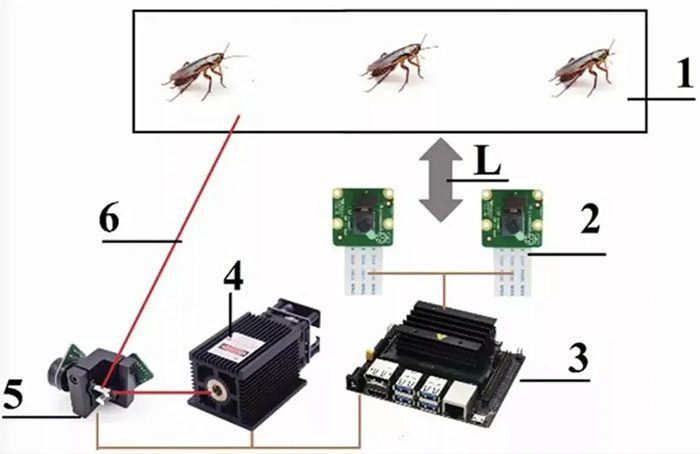According to an article published on September 21 in the journal Oriental Insects, a type of AI-controlled laser weapon capable of identifying and eliminating cockroaches has been successfully developed. This product introduces a completely new method for controlling pest species, as it can “send off” each bug from a distance of up to 1.2 meters without the need for any harmful chemicals.
“In this study, we created an automated laser system powered by computer vision, aimed at disabling and manipulating the behavior of insects,” the authors wrote. “By conducting experiments on the German cockroach, scientifically known as Blattella germanica, we demonstrated that our method can selectively and immediately disable individual insects from a distance of up to 1.2 meters.”
Cockroaches are among the most common pest insects worldwide, known for contaminating food and wreaking havoc on crops, while also leaving an unpleasant odor in households. According to 2021 data from the US Census, 14 million out of approximately 124 million households in the U.S. reported having discovered cockroaches in their homes in 2020.
“Pest control is a significant issue for the food industry and public health. Current agricultural chemical measures for controlling pest insects often have limitations, as they can lead to drug resistance over time and often affect non-target species as well,” the researchers noted.
To control cockroach populations, common methods used include bait treated with hydramethylnon or fipronil and boric acid powder, as well as pesticides containing deltamethrin or pyrethrin. However, these methods can be harmful to pets and humans, and they also affect beneficial insect species like bees. Cockroaches can even develop resistance to chemicals over time.
Therefore, controlling pests using lasers seems to be an effective method for eliminating cockroaches in the future without the concerns associated with harmful chemicals. This is particularly noteworthy in the coming years as the consequences of climate change become increasingly severe: rising global temperatures will lead to changes in population dynamics, making pest species an even bigger problem, especially for agriculture.
Higher temperatures will increase the physical activity and metabolic rates of insects, causing them to attack crops more frequently. Additionally, climate change leads to shifts in planting areas and the habitats of pest species, which may not have their natural enemies present, allowing pest populations to explode.
The authors hope that the laser pest elimination system could be an effective solution for removing insect pests without impacting other important species.
“The parameters in the system can be adjusted for application in various situations and targeting different pest species, such as mosquitoes, locusts, and caterpillars. The goal of this research is to create an independent, environmentally safe, compact, cost-effective, and energy-efficient system for pest control,” the authors wrote.
The system itself operates using artificial intelligence (AI) to detect and identify cockroaches through a camera, before firing a laser to eliminate the target. Researchers have trained the AI to recognize what a cockroach looks like under various lighting conditions and positions.

Structure of the laser device: 1 – transparent box containing cockroaches, 2 – Pi camera, 3 – Nano Jetson, 4 – laser, 5 – power meter, 6 – laser beam, L – distance between the laser device and the target.
“We used 1,000 images prepared under different lighting conditions to enhance the effectiveness of the study at any time of day,” the authors wrote.
However, this pest control method also has its drawbacks and dangers due to the use of a sufficiently powerful laser to eliminate insects.
“It is extremely important to note that this device should only be used in areas where the likelihood of the laser beam hitting non-target living objects is minimized,” the authors wrote. “The goal of the research is to demonstrate the ability to use lasers for controlling pest insects, but we understand that there are still safety issues regarding the use of lasers in pest control processes that need further investigation.”
If you are unaware, lasers can cause serious damage to the eyes, meaning that if this device is used indoors, it can be dangerous for adults, children, and pets alike.
“We do not recommend using this device as it is dangerous,” said Ildar Rakhmatulin, a researcher at Heriot-Watt University and the team leader. “The laser beam can cause harm not only to cockroaches but also to your eyes.”
Laser beams can damage the cornea, lens, and retina by burning tissue, depending on their wavelength. Lasers can also enter blood vessels and cause blockages, or even affect areas where the nerves run from the eyes to the brain.


















































